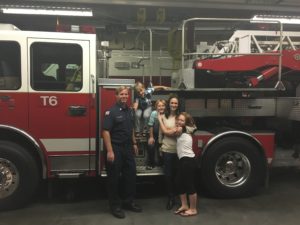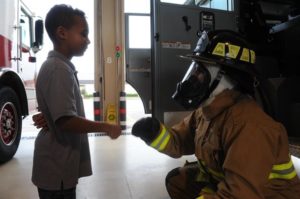Firefighters Should Easily Embrace Community Risk Reduction, Shouldn’t They?
On the surface, it would seem that it would be easy to get firefighters to embrace Community Risk Reduction. Unfortunately, that is not always the case. Many fire chiefs have met road blocks with their Community Risk Reduction plans by the firefighters who work with them. There are a few things we can do to get a better response to this important effort.
Operations vs. Fire Prevention
Admittedly, I have served over 20 years in the operations side of the fire department family. Whether we want to admit it or not, there is often a rift between Operations and Fire Prevention. Both groups want to protect the public, but we often have very different ways to do it. Once we admit there is a struggle within our fire family, we can begin to look for ways to overcome them.
Operations personnel often have difficulty with Community Risk Reduction due to “Peer Pressure” from other firefighters, lack of understanding of where Community Risk Reduction fits in the fire service, and they are often uninformed on the “why.” If our Community Risk Reduction programs are to succeed, we need to take an honest look at each of these within our organizations.
Peer Pressure and Community Risk Reduction
Peer pressure is alive and well in the fire service, how we utilize it is the key. Both negative and positive peer pressure can be found within our agencies. Attitudes and perceptions within an organization can be very difficult to mold, change, and understand. Some chiefs have been blindsided to the negative attitudes of their firefighters regarding Community Risk Reduction. A thorough understanding of where the organization is at is needed prior to introducing a new concept or program. Look to those who can “see the vision” and who have influence to spread the word. Be aware of those who do not “see the vision” and who have influence. Take the time to understand their concerns and help them with their vision or they may be the downfall of something very important.
Where does Community Risk Reduction Fit in the Fire Service?
As a whole, I think it has been detrimental that many agencies have tied Community Risk Reduction to Fire Prevention. Some Operations personnel automatically decide that Community Risk Reduction is not their responsibility because it is a Fire Prevention activity. Nothing could be further from the truth. Community Risk Reduction is such a broad topic and Fire Prevention is only one of the “Programs” within the “Process” of Community Risk Reduction. Having a well staffed, trained, and equipped Operations Section falls under the Community Risk Reduction “Process” as well.1
Community Risk Reduction is a “Process” not a “Program,” but there are “Programs” within Community Risk Reduction. A proper Community Risk Reduction process looks at the true risk of the area an agency serves and comes up with ways to reduce those specific risks. Some examples of risks for a community may be the obvious ones we have looked at in the past like Fire Prevention and Emergency Preparedness, but may include issues such as drug and alcohol addiction, elder abuse, fall prevention, homelessness, and many others. Don’t get overwhelmed, Community Risk Reduction involves the “Community” so we can’t be the only ones doing it. There are many other organizations public, private, religious, secular, and service organizations that we need to team up with and refer to when we don’t specialize in an area.
The “WHY” of Community Risk Reduction

For many reasons, the newer generations have been labeled as needing to know the “Why.” There is even an organization dedicated to this.2 There have been many books, articles, and presentations on how to lead these generations. There is a lot of great information out there. I’d like to add my spin to it. An effective leader will harness and embrace whatever is needed to move things forward. If that means you need to do something differently than has been done in the past, get over it and do it. It’s okay and important to ask and explain the “Why.”
To explain the “Why” is to give them your vision and even more important for them to have their own vision. When they have their own vision, they will actually make opportunities to move things forward rather than just do what they are told. This “Why” is expressed in many regards through metrics. When we can show the risk and and the outcome of decreasing that risk, the “Why” comes into view. Allowing those at all levels to understand the “Why” and be apart of the “How” will pay dividends in all that we do.
There is no time for Community Risk Reduction
This is an often heard concern when introducing Community Risk Reduction. It also may be a very valid one. I do not think most departments have less calls for service than we have had in the past. I look at my agency as an example. When I started with my current agency we ran around 25,000 calls a year. We are now running over 40,000 calls a year with no increase in staffing. Training requirements are much higher and more time consuming than they were in the past. We are more involved in community activities at every level. It is not the same job as when I entered the fire service.
What are the priorities? As leaders, we need to be very clear about what our priorities are. To continue expecting more with the same or less only sets us up for failure. Technology such as Virtual CRR can fill some of these gaps, but nothing will substitute for clear priorities. I read an article titled, Good, Better, Best3 that has nothing to do with the fire service but the ideals can be applied to us. Just because something is Good or even Better doesn’t mean we should be doing it. What are the best things for our departments and communities? These should be our priorities. Don’t get mired in the Good and Better, that the Best never get done.
Firefighters and Community Risk Reduction
Is there a place for the Operations family members of our departments in Community Risk Reduction? Yes! It probably will not and probably should not be the same role as our Fire Prevention family members. Each group has their strengths as well as their weaknesses. More importantly, each individual in these groups has strengths and weaknesses. Look to how the individual can make a difference when it comes to Community Risk Reduction. Be an effective leader at any rank or position by moving your Community Risk Reduction process forward.
 Brent Faulkner is a founding member of MBIntel and now serves as its CEO. He has 20 years of experience in the fire service. During this time, he has responded to numerous emergency situations including structure fires, wildland fires, hazardous materials responses, emergency medical situations, and numerous types of rescues. In addition, he has served on a Type 1 Hazardous Materials Response Team for 14 years.
Brent Faulkner is a founding member of MBIntel and now serves as its CEO. He has 20 years of experience in the fire service. During this time, he has responded to numerous emergency situations including structure fires, wildland fires, hazardous materials responses, emergency medical situations, and numerous types of rescues. In addition, he has served on a Type 1 Hazardous Materials Response Team for 14 years.
Brent had a defining moment in his career which, as a result, lead him to MBIntel and his passion for Community Risk Reduction. He lead a team in critical infrastructure protection at a recognized Department of Homeland Security (DHS) Terrorism Fusion Center. This team was responsible for increasing the safety of critical infrastructure as it relates to terrorism, general security, and natural disasters. He also specializes in emergency preparedness for homeowners and businesses. He has a master’s degree in management, a bachelor’s degree in occupational studies, an associate’s degree in hazardous materials response, and another in fire science.
2 – startwithwhy.com

 Photo Credits Link
Photo Credits Link